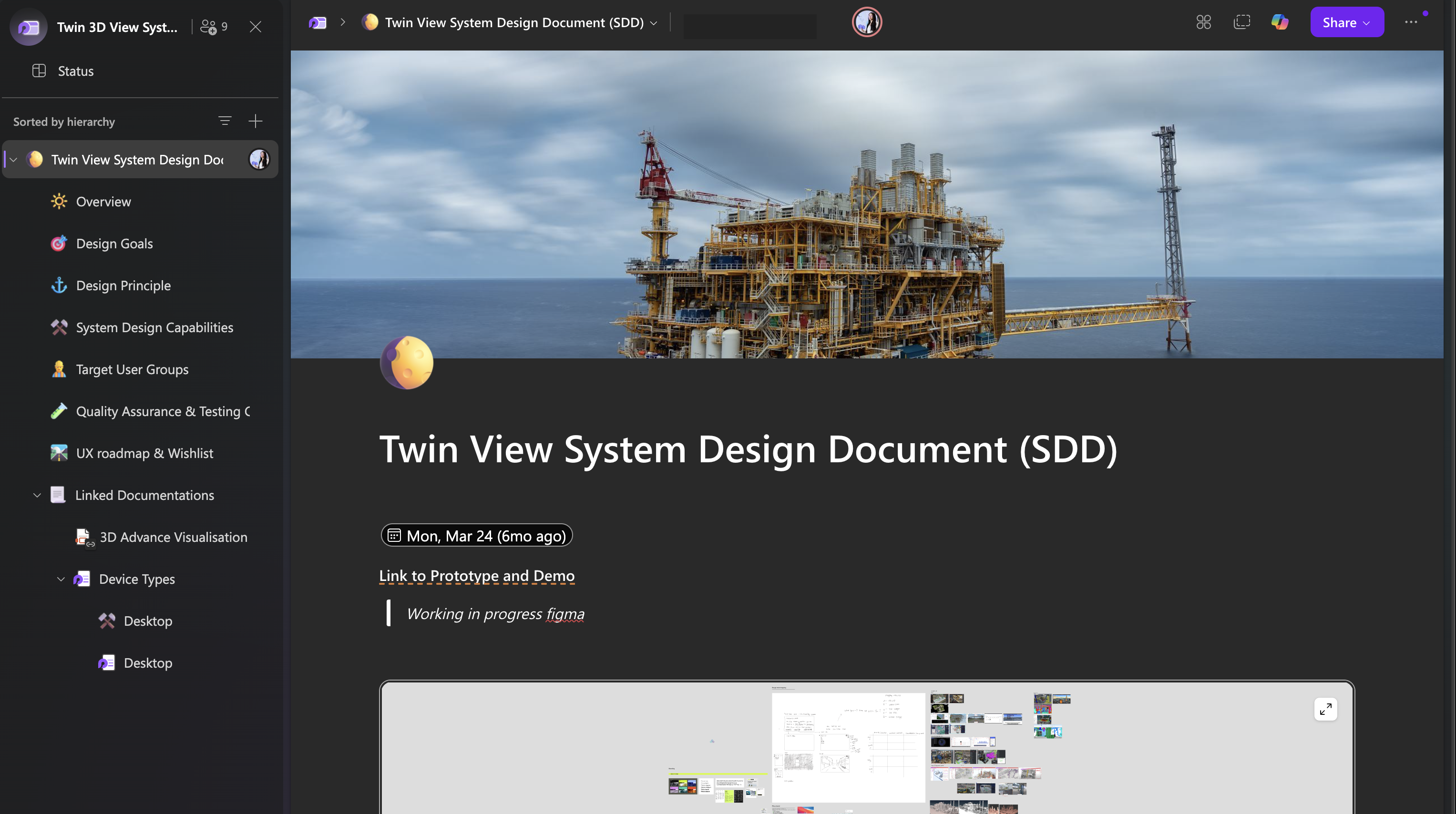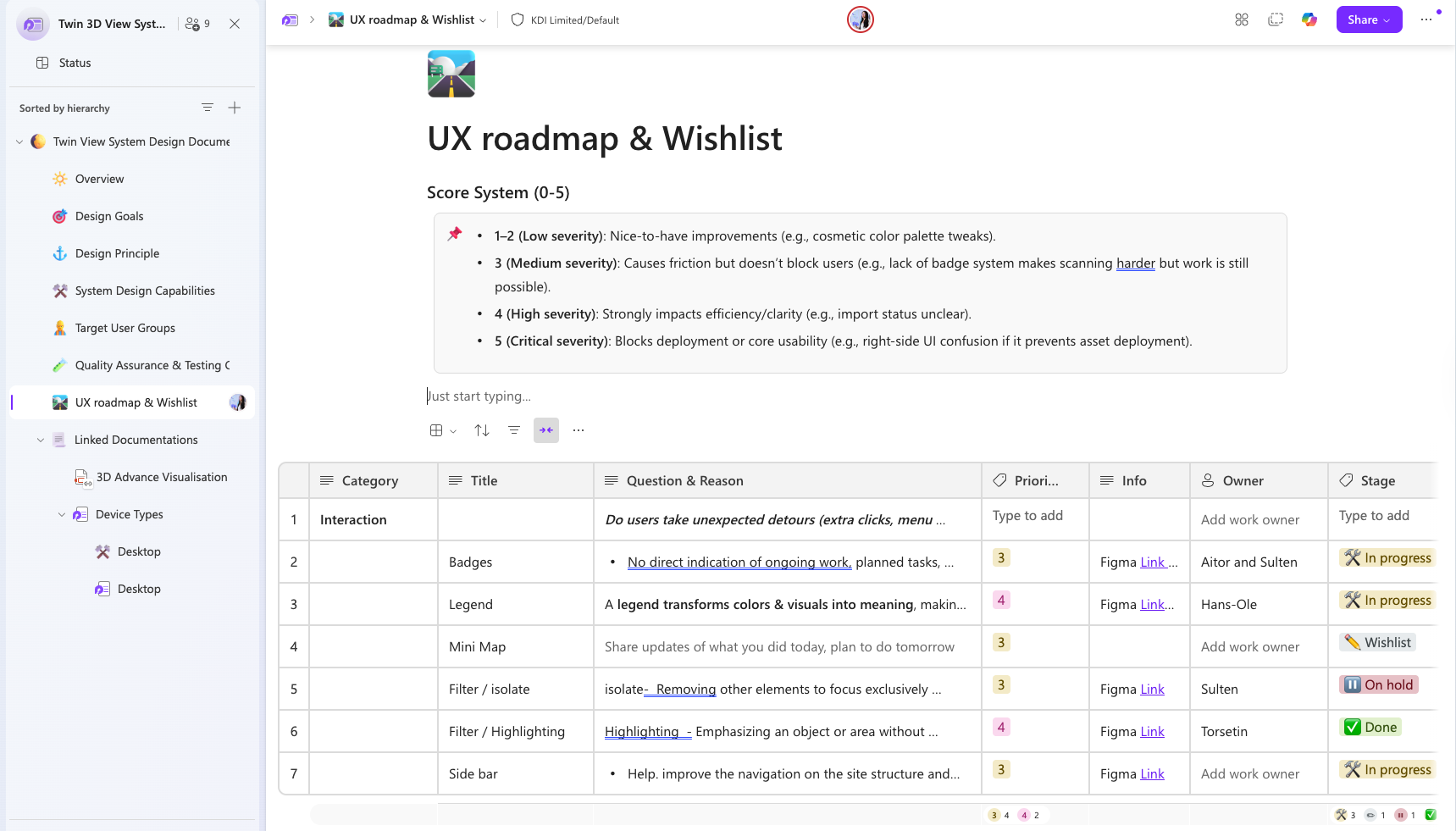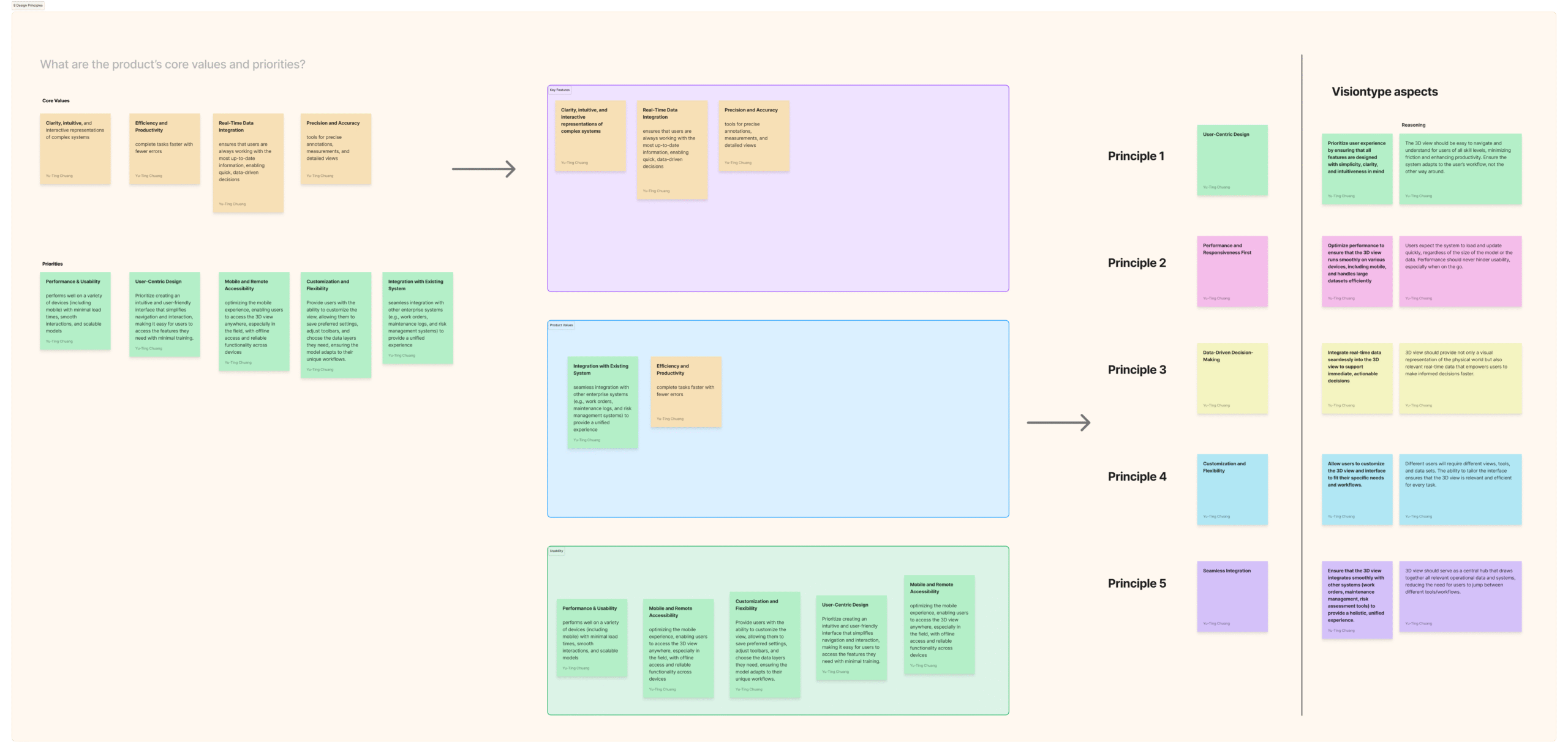The Context
When I first began working on the Twin View System Design Document (SDD), the goal wasn’t to make a pretty PDF — it was to build a shared foundation.
The 3D view in Twin View had become a shared component used across multiple products, and without consistent principles, each team risked interpreting it differently.
At the same time, the earlier 3D Vision findings revealed a bigger truth: the 3D experience wasn’t just a visual layer — it was the core decision-making environment connecting data, people, and systems.
That realization made documentation essential. The SDD became a way to align everyone — designers, developers, product owners, and stakeholders — under one clear understanding of how the 3D system should work, look, and feel.
What led me to build the SDD
- Diverging context: Teams were operating in silos. Features were being designed with overlapping intent, but with inconsistent rules.
- Lack of shared reasoning: Many UI decisions (split behavior, view assignment, fallback logic) lacked documented rationale, which made future changes fragile.
- Need for alignment: Product, UX, and engineering needed a shared language and reference point when debating trade-offs.
- Complexity growth: As more views and workflows were added, the number of edge states and exceptions ballooned. Without a clear anchor, we risked user confusion and developer rework.
A behind the scenes look at how the Twin View System Design Document brought structure and shared understanding to a growing 3D product,building on insights from the earlier 3D Vision findings, and establishing clear principles for a shared component now used across multiple products.
Building a Common Language
The Overview sets the tone: Twin View isn’t just a product, but an ecosystem. Each section of the SDD was written to connect user insight, system behavior, and implementation logic.
Insight:
The SDD redefines documentation as a design tool. It turns scattered details into shared language — bridging product strategy, design rationale, and technical feasibility.
The Process

Overview — setting the foundation
What it shows:
The Overview positions the SDD as a strategic foundation rather than a static technical file. It defines Twin View as a system-of-systems — an ecosystem that must bridge data, spatial awareness, and user interaction across multiple products.
Insight:
This section establishes the why behind the SDD; the need for a unified mental model to guide all design and engineering efforts. It signals a move from feature-centric development to systemic product thinking. The emphasis on shared understanding reflects a mature UX mindset — building a document that shapes organizational alignment, not just design output.
Design Goals — Translating vision into direction
What it shows:
The Design Goals define what success looks like for Twin View — goals such as “Maintain context,” “From insight to action fast,” and “Scalable and modular”.
Insight:
These goals act as a contract between experience and performance. They embody a principle-driven approach where usability, responsiveness, and decision-making speed are equally prioritized.
There’s also a strong signal of design empathy — recognizing that users in industrial settings need clarity, not visual noise. The repeated focus on time as an axis (past → live → predictive) demonstrates thoughtful integration of data and spatial storytelling.
Takeaway:
This section effectively converts abstract vision into actionable design direction. It balances the user’s cognitive load with the system’s data complexity — a hallmark of well-grounded UX leadership.
Design Principles — The DNA of the Twin View Experience
What it shows:
The Design Principles section lays out five foundational pillars:
- User-Centric Design
- Performance and Responsiveness
- Data-Driven Decision-Making
- Customization and Flexibility
- Seamless Integration
Insight:
These principles demonstrate a transition from designing for users to designing around users. “Performance and responsiveness” being elevated to a principle — not an afterthought — shows awareness that in heavy-data environments, speed is UX.
Equally, “Seamless Integration” positions Twin View not as an isolated interface, but as a connective hub within a broader operational landscape.
The inclusion of customization and adaptability acknowledges that one-size-fits-all fails in cross-domain products — especially when multiple teams share the same 3D component across products.
Takeaway:
The principles anchor design decisions in consistency and scalability. They bridge aesthetic UX with industrial utility — creating a shared philosophy across teams.
User Groups — Designing for Roles, Not Personas
What it shows:
The User Groups document outlines roles such as operator, engineer, asset manager, and planner, each mapped to distinct goals and contexts.
Insight:
Instead of generic personas, this section focuses on functional roles — a pragmatic approach for enterprise-grade products. Each user group has different visibility and control needs, highlighting the tension between overview and focus in 3D environments.
This design framing acknowledges that “user experience” is contextual: an operator’s priorities differ radically from a manager’s, and the system must flex to both.
Takeaway:
The structure supports role-based UI configurations — paving the way for dynamic layouts, permissions, and task-driven filtering.
System Design Capabilities — The Engine Room of the Product
What it shows:
This section articulates the capabilities that make the 3D view functional and scalable — navigation, spatial awareness, data layer handling, and cross-system connections.
Insight:
It reveals a deep understanding of how UX and system logic interlock. The emphasis on “capabilities” rather than “features” elevates the document to a platform-level abstraction. It’s not about buttons; it’s about what users can do.
By capturing both the behavioral rules and the technical scope, this section enables design and engineering to operate from the same blueprint — reducing ambiguity and redundant decision-making.
Takeaway:
This is the core of the SDD’s strategic value: codifying system behaviors in a way that’s both human-readable and technically implementable.
UX Analysis — Turning Observation into Framework
What it shows:
The UX Analysis document synthesizes user testing, interviews, and discovery insights — identifying friction points, priorities, and possible solutions.
Insight:
This is where the documentation matures from descriptive to diagnostic. It reflects a design culture that learns through iteration and shared testing. The analysis connects design intent with measurable outcomes — what users actually experience versus what designers assumed.
It also reveals a consistent feedback loop: findings from the 3D vision research directly influenced the design principles and subsequent component logic.
Takeaway:
By grounding UX patterns in observation, not opinion, this section strengthens the SDD’s credibility as a living evidence-based design tool.
Quality Control — Ensuring Consistency Beyond Design
What it shows:
This file outlines processes for maintaining design quality, ensuring that the delivered product matches the documented UX logic and visual intent.
Insight:
It represents the bridge between design theory and delivery. The focus on internal user documentation and visual references shows a commitment to clarity and collaboration — reducing the translation gap between design, testing, and engineering.
Takeaway:
Quality control in this context isn’t just about testing functionality — it’s about preserving design intent across releases and contributors.

What This Process Taught Me
Documentation is design. A well-structured document shapes how teams think, decide, and collaborate.
System thinking creates clarity. Once principles were defined, design reviews shifted from debating pixels to discussing patterns and logic.
Shared ownership matters. The SDD worked because developers, designers, and PMs wrote it together.
Simplicity is power. The more complex the system became, the more valuable it was to return to simple, human-centered principles

Reflection
Looking back, the SDD wasn’t just about defining a 3D product — it was about creating a shared design culture.
It documented not just how Twin View works, but how we work together to make it meaningful, consistent, and scalable across products.
From problems to priorities: using the opportunity solution tree in core teams
Product discovery: what-if scenarios for smarter decisions in digital twin
Designing for millions: Product Research on Taiwan’s NHI (National Health Insurance)App
(47) 41 33 16 51
Reach Me By Phone
contact@yutingchuang.com
Email Me
Rølivegen 367, Steinkjer, 7718, Trøndelag
📍 Based in Norway

